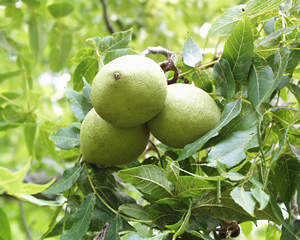
Plant Description
Caution & Interaction

Latin (botanical) name:
Juglans nigra
Common names:Carya, Jupiter's Nuts
Plant Description: While the Black Walnut is not native to North America, it is still found in the wooded areas of the United States. It is thought to have originated in Persia. It has been documented that the Black Walnut tree can live in excess of 300 years and reaches a height of 60 feet with a circumference of 23 feet. The tops of the tree spread wide in relation the enormous stem. This tree bears the fruit of both sexes and begins to bud in the early spring even before its leaves sprout. The calyx of the male flower may have five or six scales which surround as many as thirty-six stamens while the female flower envelopes only the ovary which contains two or three fleshy stigmas.
Medicinal Properties &Uses: While there are those who say that Black Walnut hulls can effectively reduce the risks of heart attacks, it is more widely known for its anti-parasitic qualities. It is said to have effectively killed more than 100 known parasites. It has been proven to be a strong natural remedy for the treatment of acne, thyroid disease, colitis, eczema, hemorrhoids, ringworm, sore throats, tonsillitis, skin irritations, and wounds.
Dosage: 20-40 drops in juice or water, 2 times daily or as needed. Shake well before using.
Cautions & Interactions: Keep out of reach of children.
Efficacy Studies & Other Clinical Data:
Disclaimer (U.S. Only): These statements have not been evaluated by the FDA. These products are not intended to diagnose, cure, treat, or prevent any disease.
Common names:Carya, Jupiter's Nuts
Plant Description: While the Black Walnut is not native to North America, it is still found in the wooded areas of the United States. It is thought to have originated in Persia. It has been documented that the Black Walnut tree can live in excess of 300 years and reaches a height of 60 feet with a circumference of 23 feet. The tops of the tree spread wide in relation the enormous stem. This tree bears the fruit of both sexes and begins to bud in the early spring even before its leaves sprout. The calyx of the male flower may have five or six scales which surround as many as thirty-six stamens while the female flower envelopes only the ovary which contains two or three fleshy stigmas.
Medicinal Properties &Uses: While there are those who say that Black Walnut hulls can effectively reduce the risks of heart attacks, it is more widely known for its anti-parasitic qualities. It is said to have effectively killed more than 100 known parasites. It has been proven to be a strong natural remedy for the treatment of acne, thyroid disease, colitis, eczema, hemorrhoids, ringworm, sore throats, tonsillitis, skin irritations, and wounds.
Dosage: 20-40 drops in juice or water, 2 times daily or as needed. Shake well before using.
Cautions & Interactions: Keep out of reach of children.
Efficacy Studies & Other Clinical Data:
- National Toxicology Program Fact Sheet
- BetterLife.com - Research on Black Walnut
- Juglans nigra Medicinal Uses
- Black Walnut Information
- Natural Health Notebook: "Antiseptic hulls fight parasites and skin problems"
- The Herbal Encyclopedia - Walnut, Black
Disclaimer (U.S. Only): These statements have not been evaluated by the FDA. These products are not intended to diagnose, cure, treat, or prevent any disease.